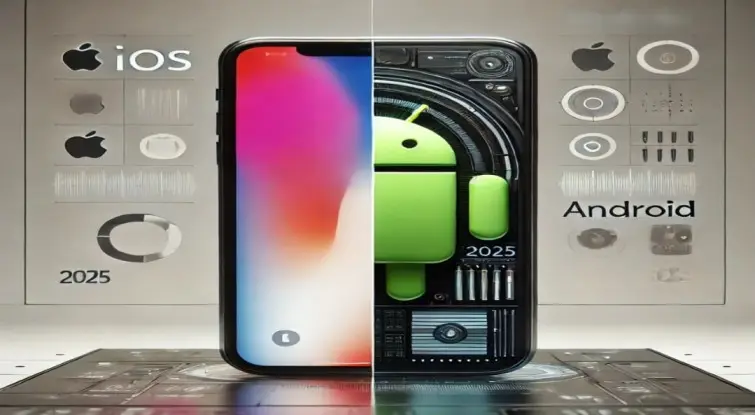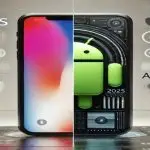The rivalry between iOS and Android continues to dominate the tech world, with each platform offering unique features and experiences. As we step into 2025, the debate remains as heated as ever. This article delves into the strengths, weaknesses, and new advancements of iOS and Android, helping you decide which platform suits your needs better.
Comparison Table: iOS vs Android in 2025
| Feature | iOS | Android |
|---|---|---|
| User Interface | Elegant and user-friendly; dynamic widgets and streamlined navigation. | Highly customizable; Material You design for personalized experiences. |
| Hardware Integration | Tight ecosystem with seamless device continuity. | Diverse device options and cutting-edge innovations like foldables. |
| App Ecosystem | High-quality, exclusive apps with strict quality standards. | Broader range of apps; supports third-party stores. |
| Security and Privacy | Robust privacy with features like App Tracking Transparency. | Improved privacy dashboard; needs caution due to open platform. |
| AI and Machine Learning | On-device processing prioritizing privacy; refined Siri integration. | Advanced real-time AI capabilities like Google Assistant and translation. |
| Price and Affordability | Premium pricing but offers trade-ins and subscription models. | Wide range from budget to flagship devices, catering to all demographics. |
1. User Interface and Experience
iOS in 2025
Apple’s iOS remains synonymous with simplicity and elegance. The interface has become even more refined with the latest update, iOS 19, which introduced:
- Dynamic Widgets: Interactive widgets that adapt to user behavior.
- Universal Search Enhancements: A more intuitive Spotlight Search that integrates AI predictions.
- Streamlined Navigation: Improved gestures for multitasking.
- Focus Modes: Enhanced options for users to prioritize work or relaxation without distractions.
Apple’s minimalist design philosophy ensures a consistent and visually appealing experience. The subtle animations and precise touch responses contribute to its reputation for quality. For users who value aesthetics and seamless functionality, iOS continues to set the standard.
Android in 2025
Android’s flexibility continues to attract a wide range of users. Android 15, the latest version, boasts:
- Advanced Customization: Enhanced Material You design for deeper personalization.
- AI-Powered Features: Adaptive battery and performance optimization through AI.
- Multi-Device Sync: Seamless integration with other Android devices, including wearables and smart home gadgets.
- Custom Themes: Users can design and share unique themes tailored to their preferences.
Android’s open-source nature allows manufacturers to innovate and offer diverse user experiences. From unique launchers to dynamic wallpapers, Android’s versatility ensures something for everyone.
Winner: Android for customization; iOS for user-friendly design.
2. Hardware Integration
iOS
Apple’s ecosystem is tighter than ever. With the release of the iPhone 16, iPads, and Macs, users benefit from:
- Seamless Continuity: Handoff, AirDrop, and Universal Clipboard work flawlessly.
- Exclusive Features: Features like FaceTime Holograms and Spatial Audio provide immersive experiences.
- Proprietary Hardware: Apple’s M-series chips ensure unparalleled performance and energy efficiency.
The integration between Apple devices is unmatched. Features like Sidecar, which allows iPads to function as secondary displays, and the new Universal Control for effortless device switching, further enhance the ecosystem’s appeal.
Android
Android’s open platform supports a variety of manufacturers, including Samsung, Google Pixel, and OnePlus. New advancements include:
- Diverse Options: A wider range of devices catering to different budgets.
- Interoperability: Improved connectivity with non-Android devices, such as Windows PCs and IoT products.
- Innovative Features: Foldable screens and modular designs push the boundaries of smartphone capabilities.
While Android’s hardware ecosystem lacks the cohesiveness of Apple’s, it compensates with variety and cutting-edge innovations, giving users the freedom to choose devices that suit their needs.
Winner: iOS for a unified ecosystem; Android for device variety.
3. App Ecosystem
iOS
The Apple App Store remains a hub for high-quality apps. Developers often prioritize iOS for:
- Early App Releases: Many apps debut on iOS first.
- Strict Quality Standards: Ensures user security and app reliability.
- Exclusive Apps: A range of apps and games exclusive to the Apple ecosystem.
Apple’s closed ecosystem ensures better optimization for apps, resulting in smooth performance. From creative tools to professional-grade software, iOS users enjoy access to premium applications.
Android
The Google Play Store has expanded its offerings with:
- Open Accessibility: A broader range of apps, including experimental ones.
- Third-Party Stores: Options like Samsung Galaxy Store and Amazon Appstore add diversity.
- Affordable Apps: Competitive pricing and frequent discounts attract users.
Android’s app ecosystem offers unparalleled variety, catering to niche interests and experimental tech enthusiasts. While it occasionally struggles with quality control, the vast selection remains a major advantage.
Winner: iOS for premium apps; Android for versatility.
4. Security and Privacy
iOS
Apple has doubled down on privacy with features like:
- App Tracking Transparency: Gives users control over data sharing.
- On-Device Processing: Keeps sensitive data offline for enhanced security.
- iCloud Encryption: Full end-to-end encryption for iCloud backups.
Apple’s commitment to privacy extends to features like Mail Privacy Protection, which prevents email tracking, and Safari’s Intelligent Tracking Prevention. These tools give users peace of mind in an increasingly data-driven world.
Android
Android’s security measures in 2025 include:
- Google Play Protect: Regularly scans apps for malware.
- Privacy Dashboard: Provides a detailed overview of data usage.
- Enhanced Permissions: Fine-grained control over app permissions.
While Android has made significant strides in privacy, the open nature of the platform occasionally exposes users to risks. Regular updates and careful app selection remain essential for Android users.
Winner: iOS for robust privacy; Android for transparency.
5. AI and Machine Learning
iOS
Apple’s AI integration in iOS 19 focuses on:
- Siri Intelligence: More contextual and proactive suggestions.
- Photo and Video Editing: AI tools for professional-level editing.
- Health Insights: Advanced health monitoring through AI-driven analytics.
Apple’s AI features emphasize privacy, ensuring all data processing occurs on-device. This approach balances innovation with security, appealing to privacy-conscious users.
Android
Android 15 leverages AI in:
- Google Assistant: Enhanced conversational abilities.
- Live Translation: Real-time multilingual translation across apps.
- Smart Recommendations: Context-aware suggestions across apps and services.
Google’s AI capabilities remain a step ahead in terms of versatility and real-time applications. From smart home integration to advanced natural language processing, Android users benefit from cutting-edge AI technologies.
Winner: Android for advanced AI; iOS for polished implementation.
6. Price and Affordability
iOS
Apple devices remain premium-priced, with the iPhone 16 starting at $999. However, Apple has introduced:
- Subscription Models: Monthly payment plans for devices and services.
- Trade-In Options: Discounts for upgrading from older devices.
Despite its higher cost, Apple offers exceptional value through longevity and resale value. iPhones, for instance, receive software updates for up to 6 years, making them a worthwhile investment.
Android
Android caters to a broader audience with devices ranging from $100 to $2000. Budget brands like Xiaomi and Realme offer exceptional value. Additionally, flagship models like Samsung’s Galaxy S series compete directly with Apple’s premium offerings.
Android’s affordability makes it accessible to a wider demographic, ensuring no one is left out of the smartphone revolution.
Winner: Android for affordability.
Both iOS and Android have made significant strides in 2025, catering to different user needs. If you value a polished, cohesive ecosystem and prioritize privacy, iOS is the way to go. On the other hand, if customization, variety, and affordability are your priorities, Android is the better choice.
Ultimately, the choice between iOS and Android depends on your individual preferences and requirements. With both platforms continually innovating, users are the real winners










